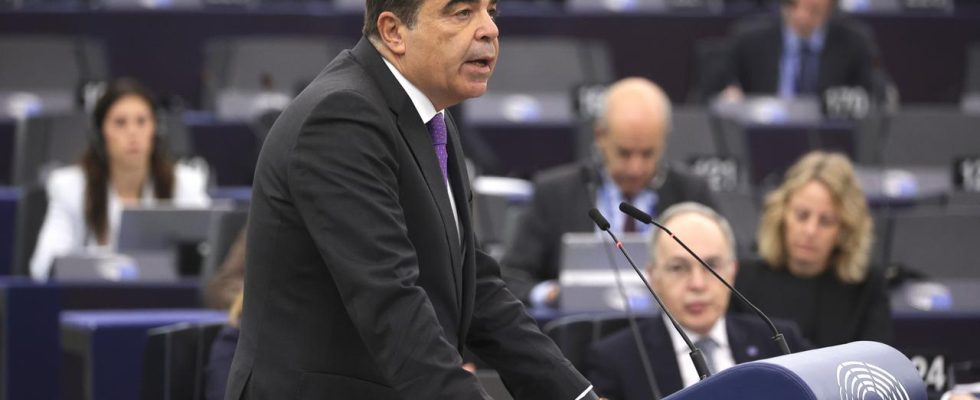The EU states agree on a crisis regulation for an EU asylum package – negotiations with Parliament can now begin. There was a debate in the morning – many reservations became clear.
For too long, the European community has acted in a dual role, simultaneously as an architect and a firefighter – with these words, the EU Commissioner responsible for migration, Margaritis Schinas, set the tone for the debate on migration policy in the European Parliament.
As a fire department, Europe is again looking at the situation on Lampedusa or on the Polish border with Belarus, where many migrants are trafficked by smugglers, often with the destination Germany.
There must finally be an end to this short-term work on the fire front, says Schinas: “We react to different events, to small fires here and there with ad hoc measures and patchwork rules. That sometimes leads to results, but it hinders us “We are working to achieve full efficiency, unity and solidarity. We can only achieve this with the Pact on Asylum and Migration.”
Now we can negotiate
So, as he sees it, it’s time to finally finish building this scaffolding. A decisive step towards this was taken today – outside Parliament. The EU member states had been wrestling with the final details of the crisis mechanism since the interior ministers met at the end of last week. The question is how far a country that is under particular migration pressure can temporarily lower the standards in the asylum procedure.
Now there has been the green light – negotiations with the European Parliament on this could begin soon. But this is not a sure-fire success, emphasizes Birigt Sippel, the domestic policy spokeswoman for the Social Democrats in the European Parliament: “Neither of the two institutions can decide on the migration package on their own. Both sides have to make compromises. However, some member states are not willing to do so.”
Which approach reduces migration?
There is a need for discussion, especially about the crisis mechanism. According to the Green migration expert Erik Marquardt, the agreement now negotiated in the Council shows that many member states believe that “they simply have to treat refugees a little worse than they do today; they should always treat them a little worse every day than they did yesterday – and then they would “They’ll stop coming at some point. I mean: You could, for example, make agreements now that improve the situation on the ground and create legal paths.”
The migration agreements are another sore point for many in Parliament, as today’s debate shows. The head of the conservative EPP group, Manfred Weber, sticks to a “pragmatic approach” and looks at the agreement between the EU and Tunisia: “It is a real agreement. 90 percent of the boats leave from Tunisia. We can only control the external border Humanitarian control is correct if we do it in partnership with our neighbors, no matter how difficult these neighbors may be. And this agreement is also a model for other agreements in North Africa.”
Criticism of the agreement
A blueprint – this is apparently giving more and more EU parliamentarians a stomach ache. At the beginning of the week, Tunisian President Kais Said announced that his country would not accept “anything that resembles grace or alms” and thus essentially rejected the hundreds of millions of euros in EU aid.
In return for this financial aid, he was supposed to prevent those who wanted to flee from crossing the Mediterranean – the outcome was uncertain. The vice-chairman of the SPD parliamentary group in the European Parliament, Pedro Marques, criticizes: “Wanting to outsource the challenge of migration will be a disaster. Especially when you think that hundreds of millions for authoritarian rulers would be the trick. We also have to take care of the many other aspects of migration address.”
Marques is addressing what many MPs have found lacking in the pact: namely the recognition that both sides of the coin need to be covered. Significantly more deterrence measures would have to go hand in hand with more solutions for intra-European solidarity, i.e. when it comes to accepting refugees. For example, there are more than 600,000 people who are going through asylum procedures this year alone and are therefore supporting legal immigration to Europe.
Baerbock and Faeser speak of success
Federal Interior Minister Nancy Faeser (SPD) described the agreement on the crisis mechanism as an important step forward. Since the Council’s position on the crisis regulation has now been formally decided, negotiations with the European Parliament on a common European asylum system can now continue, Faeser announced in Berlin. She was happy that this was successful and that the federal government was able to enforce its ideas of humanity and order.
Foreign Minister Annalena Baerbock (Greens) wrote on Solidarity between member states is mandatory in the event of a crisis.
The dilemma of parliamentarians
However, with concerns such as those expressed by Marques, the EU Parliament is now increasingly in a dilemma. The member states took a long time to agree on the important chapter “crisis mechanism”.
Now the time pressure is enormous: What matters is the coming weeks, in which trilogue negotiations must start and – by the beginning of February at the latest – be concluded so that the entire pact for asylum and migration can be concluded before the European elections.
Otherwise, and of course the majority of European Parliament members do not want that, the EU would be facing total loss in terms of migration policy.

